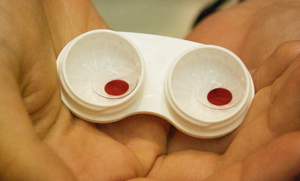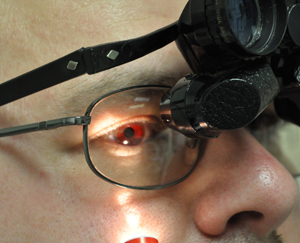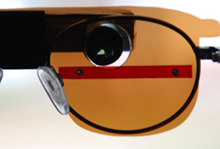The Special Case of Achromatopsia / Cone Dystrophies
For more info please visit our sister website Achromatopsia.info
In Achromatopsia and other Cone Dystrophies, patients suffer debilitating glare. It occurs due to the loss or impairment of the cone cells. New technology in the form of the Optical Coherence Tomography (OCT) allows us to verify the loss of cone cells in the fovea, the center of the macula where only cones should be found.

The cone cells have chemicals that work and are stable in bright light. Without cones cells, these patients must rely on the rod cells. Rod cells contain  a chemical that is not stable in bright light, but works well in low light levels. These patients find their vision is washed out in bright lighting. Only by reducing light levels to a dark enough level that the rod chemicals are stable can the patient function well. Dark red filters work well since they allow primarily low energy red light pass through to the eye. This prevents the cemicals in the rod cells from being bleached by the light. This is similar to the red lights used in dark rooms that do not expose the film (before digital) and the red running lights used in submarines to help submariner's eyes dark adapt before rising to the surface at night.
a chemical that is not stable in bright light, but works well in low light levels. These patients find their vision is washed out in bright lighting. Only by reducing light levels to a dark enough level that the rod chemicals are stable can the patient function well. Dark red filters work well since they allow primarily low energy red light pass through to the eye. This prevents the cemicals in the rod cells from being bleached by the light. This is similar to the red lights used in dark rooms that do not expose the film (before digital) and the red running lights used in submarines to help submariner's eyes dark adapt before rising to the surface at night.
Various filters, dark sun lenses and hats have been used by these patients, but have often not fully controlled the glare problems of these patients making it more difficult to advance to bioptic driving. However, recent  advancements in the fitting soft Red Central contact lenses have allowed our doctors to help most achromatopsia patients function better in bright lights inside and out.
advancements in the fitting soft Red Central contact lenses have allowed our doctors to help most achromatopsia patients function better in bright lights inside and out.
Our practice has worked extensively with these selective filtered contact lenses on patients from across the United States. These special red or dark amber filter contacts must be custom prescribed in different levels of darkness in, type of filter and different sizes of the filtered portion. They have revolutionized our care for Achromatopsia patients and op ened the possibility for more of these patients to be considered for bioptic driving
ened the possibility for more of these patients to be considered for bioptic driving
Profound color vision loss occurs from the lack of cone cells as these are the only retinal cells that detect color. We can help these patients detect color by the same principles used in the digital camera, video camers and color scanners. These electronic devices detect color by a filter subtraction method. If we place filters over a sensor that blocks all colors but one, when the sensor is activated we know that it has to be that one color. If we place a strip of dense red filter in front of a severely colorblind patient looking at traffic light, if the light is red, the light will pass through and be seen as bright light. But, if it is a green light it will be blocked by the red filter and disappear. Yellow lights will appear slightly faded. Thus a patient can glance in and out of the red filter strip to further verify the traffic light. Patients also learn to judge traffic lights by position of the three lights.
Thus in Achromatopsia and other Cone Dystrophies, even after we apply the red central contact lens, we may need to attach an additional small dense red filter to the base sunglass to enhance the patient’s ability to see the red stoplight. The red filter will cancel out green light but enhance the red light.
Bioptic Driving with Achromatopsia or other Cone Dystrophies requires first solving the severe photophobia and dysability glare. Second, the color vision issues related to detection of traffic sign and signals must be resolved. Third the bioptic system must be prescribed and fit. Fourth extensive behind-the-wheel training is even more important in these patients as real world driver training experence allows further resolution of the color vision and glare problems.
Not all of these patient can accomplish bioptic driving. Even though most have only moderate visual acuity loss, the glare and color vision problems can be too difficult to overcome in some patients. However, some of our patients who failed previously at becoming a bioptic driver have now succeeded with the use of Red Central Contact Lenses. We have learned that maturity and motivation are crucial. It takes more work and training for an Achromatopsia and Cone Dystrophy patient to become a bioptic driver than most other conditions we fit. If you have any question please contact our Indianpolis office at (317) 844-0919 or contact us by email.
